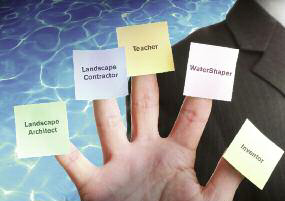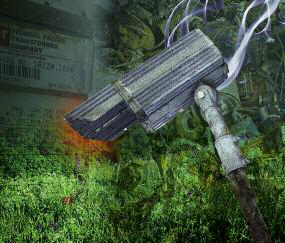landscape lighting
Looking beyond standard modes of operation is nothing new for watershapers: It’s how many of us grow professionally. In my case, for example, I’ve moved in a variety of different directions in my career, and I’ve found that each of these endeavors has added substance and insight to both my business and professional acumen. Some experiences are more valuable than others, of course, but I’ve always found something positive and a few times have watched my business transform and grow before my eyes. Looking back, it’s been quite a journey. I began my career more than 20 years ago with
Fire effects have grown tremendously in popularity in recent years, especially among swimming pool designers and builders who use them in developing various fire-on-water features. On one level, it seems that these professionals (and their clients) have noticed that systems that contain and control fire serve as wonderful complements to systems that contain and control water. On a grander scale, however, it’s apparent that, as watershape designers and builders have become more and more creative, fire features have risen in the estimation of those who want to give their clients something special – something few others have. At my company, Grand Effects of Irvine, Calif., we’ve focused on making it easy for watershapers, general contractors and landscape designers and architects to bring fire into the picture across a range of applications. To that end, we’ve developed an array of completely off-the-shelf systems, ready to install, and have done all of the engineering and testing required to build confidence into every product. In doing so, we’ve studied possible effects and developed
Call it human nature, free-market economics, the profit motive or whatever – the fact of the matter is that too many landscape lighting installers rely on low-cost products made with low-grade materials. Obviously, they do it to cut down costs either to squeeze more profit out of each job or to bring the price down to the level required to get clients to sign on the dotted line. So rather than reduce the number of fixtures used on a project or even turn down a project altogether, they’re clearly willing to win a job by using equipment that has no chance of lasting more than a
For more than 10 years now, outdoor rooms have been growing steadily in both popularity and complexity. That’s great, because it enables designers – architects, landscape architects, landscape designers and pool builders alike – to bring interiors outside and provide living spaces where activities previously associated strictly with indoor spaces can move comfortably into the great outdoors. It’s a fantastic way to expand living areas and create useful spaces while also adding entirely new types of experiences to the lives of homeowners. Among this trend’s many implications is that it has challenged landscape lighting designers to think in all-new ways about how we light exterior spaces. For starters, we need to be aware that most homeowners will enjoy these spaces exclusively after dark – and also be conscious of the fact that these environments require much more complicated lighting schemes than classic suburban patios ever did. The differences are so profound that I believe lighting designers need to talk to clients in new ways that
If there’s ever been such a thing as a match made in heaven, swimming pools and landscape lighting lay a strong claim to that perfection. Separately, they take little-used spaces and transform them to all-day hubs of activity and sources of constant beauty. Together, however, the magic starts, with pools and landscape lighting systems accentuating each other’s virtues in ways that are tough to quantify or adequately describe. To landscape lighting designers and installers, pools offer a
I’m always surprised when I run into clients or prospects who don’t appreciate or fully accept the fact that landscape-lighting systems require routine maintenance. These are people who easily recognize the need for upkeep when it comes to their swimming pools or landscapes, but this perception simply doesn’t extend to the lighting systems that frequently go along with them. I suspect this is so because dealing with lighting inside a home is so simple – basically just a matter of changing burned out bulbs as the need arises. Some also believe that landscape light bulbs should and will last forever, which is
From my perspective on the design and installation side, I see bringing landscape lighting to a property as a process that includes careful planning and execution as we compose the different scenes and lighting elements; count and select fixtures; lay out the power-distribution system; install everything properly; and, finally, fine-tune it all before turning things over to our clients. Looking at it from the other side, it’s been my observation that clients approach these projects with an equivalent level of deliberation: Even among relatively affluent clients, landscape lighting represents a significant
If you’ll recall, I used this space last month to say farewell to David Tisherman’s “Details” column. His departure left us with a significant role to fill – especially given how provocative his column had been through the years. As often happens when a key person departs an organization, we weighed the available options and, not to flatter David overmuch, decided that replacing a voice so singular would best be accomplished by
As I see it, successful landscape lighting is a two-part process: First, the designer applies aesthetic principles that create the art, then he or she supports that artistic vision with scientific and technological savvy. One without the other doesn’t work: You can’t effectively practice the art until you’ve mastered the science. In my 17 years as a lighting designer, I’ve encountered lots of professionals who have the artistic part of the equation down pat but fall well short when it comes to working with electricity. The plain fact is, you can use the best fixtures in the world and understand the aesthetic issues like the back of your hand, but if you can’t consistently deliver power to those fixtures at correct, reliable voltages, the overall system will not perform properly and has the potential to become a maintenance nightmare. There’s no way a single article can bring anyone up to speed with all of the issues involved in the science lighting. Instead, my intention here is to introduce watershapers to a basic, commonsense approach to laying out low-voltage, halogen lighting systems, the goal being to enable you to converse intelligently and persuasively with lighting designers in the interest of helping
Landscape-lighting design is my obsession: Not only do I make my living at it, but it has also reached a point where it informs the way I look at every landscape and watershape I encounter - whether I'm working on those spaces or not. When I visit almost any site - and particularly when I spot an interesting garden - I almost instantaneously begin formulating ideas about how I'd light it. That's a good thing, because it keeps me professionally sharp, but it's also a bit addictive: Once you start visualizing how dynamic particular places can be when properly lit, you get hooked on the mental exercise and start enjoying the intensity of the experience. In the beginning, of course, those clear visualizations






















